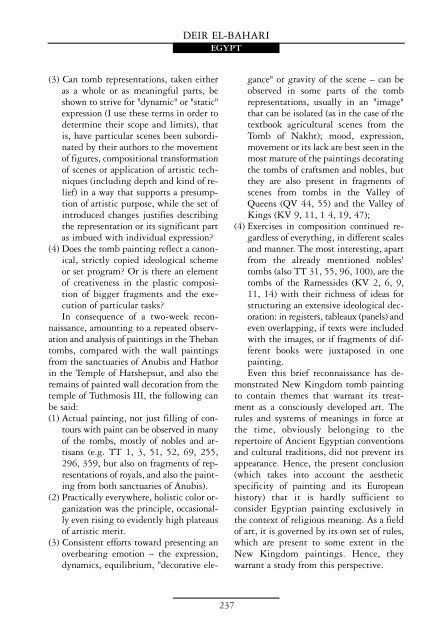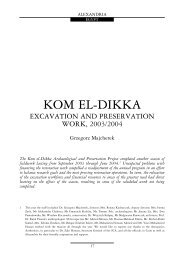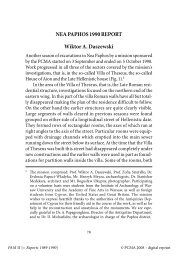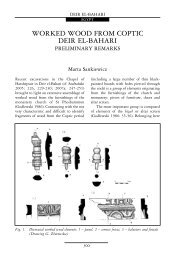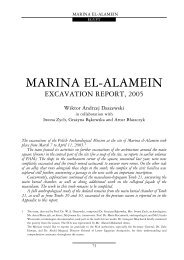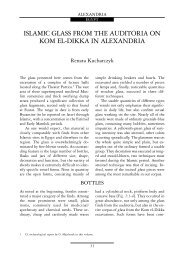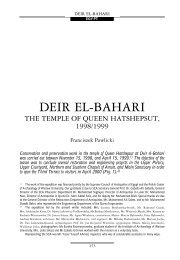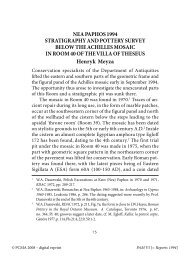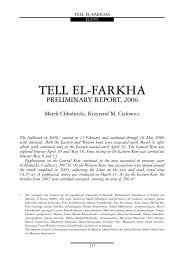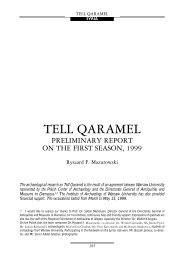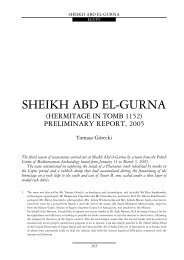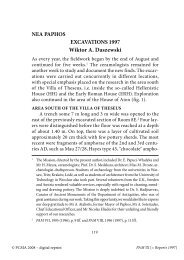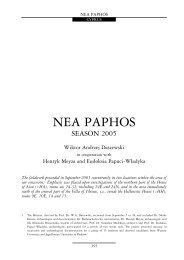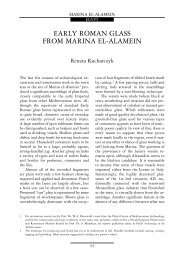DEIR EL-BAHARI
DEIR EL-BAHARI
DEIR EL-BAHARI
Create successful ePaper yourself
Turn your PDF publications into a flip-book with our unique Google optimized e-Paper software.
<strong>DEIR</strong> <strong>EL</strong>-<strong>BAHARI</strong><br />
EGYPT<br />
(3) Can tomb representations, taken either<br />
as a whole or as meaningful parts, be<br />
shown to strive for "dynamic" or "static"<br />
expression (I use these terms in order to<br />
determine their scope and limits), that<br />
is, have particular scenes been subordinated<br />
by their authors to the movement<br />
of figures, compositional transformation<br />
of scenes or application of artistic techniques<br />
(including depth and kind of relief)<br />
in a way that supports a presumption<br />
of artistic purpose, while the set of<br />
introduced changes justifies describing<br />
the representation or its significant part<br />
as imbued with individual expression?<br />
(4) Does the tomb painting reflect a canonical,<br />
strictly copied ideological scheme<br />
or set program? Or is there an element<br />
of creativeness in the plastic composition<br />
of bigger fragments and the execution<br />
of particular tasks?<br />
In consequence of a two-week reconnaissance,<br />
amounting to a repeated observation<br />
and analysis of paintings in the Theban<br />
tombs, compared with the wall paintings<br />
from the sanctuaries of Anubis and Hathor<br />
in the Temple of Hatshepsut, and also the<br />
remains of painted wall decoration from the<br />
temple of Tuthmosis III, the following can<br />
be said:<br />
(1) Actual painting, not just filling of contours<br />
with paint can be observed in many<br />
of the tombs, mostly of nobles and artisans<br />
(e.g. TT 1, 3, 51, 52, 69, 255,<br />
296, 359, but also on fragments of representations<br />
of royals, and also the painting<br />
from both sanctuaries of Anubis).<br />
(2) Practically everywhere, holistic color organization<br />
was the principle, occasionally<br />
even rising to evidently high plateaus<br />
of artistic merit.<br />
(3) Consistent efforts toward presenting an<br />
overbearing emotion – the expression,<br />
dynamics, equilibrium, "decorative elegance"<br />
or gravity of the scene – can be<br />
observed in some parts of the tomb<br />
representations, usually in an "image"<br />
that can be isolated (as in the case of the<br />
textbook agricultural scenes from the<br />
Tomb of Nakht); mood, expression,<br />
movement or its lack are best seen in the<br />
most mature of the paintings decorating<br />
the tombs of craftsmen and nobles, but<br />
they are also present in fragments of<br />
scenes from tombs in the Valley of<br />
Queens (QV 44, 55) and the Valley of<br />
Kings (KV 9, 11, 1 4, 19, 47);<br />
(4) Exercises in composition continued regardless<br />
of everything, in different scales<br />
and manner. The most interesting, apart<br />
from the already mentioned nobles'<br />
tombs (also TT 31, 55, 96, 100), are the<br />
tombs of the Ramessides (KV 2, 6, 9,<br />
11, 14) with their richness of ideas for<br />
structuring an extensive ideological decoration:<br />
in registers, tableaux (panels) and<br />
even overlapping, if texts were included<br />
with the images, or if fragments of different<br />
books were juxtaposed in one<br />
painting.<br />
Even this brief reconnaissance has demonstrated<br />
New Kingdom tomb painting<br />
to contain themes that warrant its treatment<br />
as a consciously developed art. The<br />
rules and systems of meanings in force at<br />
the time, obviously belonging to the<br />
repertoire of Ancient Egyptian conventions<br />
and cultural traditions, did not prevent its<br />
appearance. Hence, the present conclusion<br />
(which takes into account the aesthetic<br />
specificity of painting and its European<br />
history) that it is hardly sufficient to<br />
consider Egyptian painting exclusively in<br />
the context of religious meaning. As a field<br />
of art, it is governed by its own set of rules,<br />
which are present to some extent in the<br />
New Kingdom paintings. Hence, they<br />
warrant a study from this perspective.<br />
237


